There are 30 companion plants for lavender in this list along with 7 types that should be avoided. Did you know that you can enrich your garden with elegant ornamental and edible plants that also attract beneficial insects?
Lavenders are a fantastic option. But, did you know that you can pair multiple companion plants for lavender to beautify your garden even further?
Our exhaustive guide on the best plants to add to your lavender garden doesn’t just share a plain list of plants. With this guide, you will learn incredible tips for pairing the right plants with your lavenders for the best looking and elegant garden.
Heck, we’ve even thrown in a complete list of plants to avoid pairing with your blooming lavenders to ensure your garden stays healthy and beautiful. So, here’s a complete list of the best companion plants for lavender you should try planting this year.
Table of Contents
What Are The Best Plants to Plant With Lavender?
Lavender grows well with a wide range of flowering plants and vegetables. The elegant purple blooms with equally tiny green leaves work perfectly to accentuate and highlight bigger flowers and vegetables, without losing the dominance of their physical appeal.
Plus, the flowering plant complements the growth and thriving of these plants. Below, we’ve shared a complete list of the best plants to pair with nearby lavender plants.
30 Best Lavender Companion Plants
Lavender is an easy-to-grow and hardy perennial flowering plant that survives in most conditions. In fact, these beautiful “lavender” colored blooms can grow well even in the harshest of conditions. The flowering plants thrive best in USDA 5-9 zones in warm and dry weather.
Further, lavender is a sun-loving plant and does particularly badly in shade. Lavender also grows well in dry and well-drained soil, requiring little to no water, making it very low maintenance. Watering the lavender once a week is more than enough for these drought-surviving plants.
So, to successfully grow any plant near lavenders (for it to be a good companion plant), you want to pick options with similar growing needs. For example, shade-loving plants will do poorly growing near the sun-loving lavender.
A good companion plant should ideally tolerate full sun, low fertile, and well-drained soils subjected to drought. The good news is that you can find a variety of flowering plants, herbs, and vegetables that pair very well with lavender. Here’s a complete list;
Flowering Plants
1. Echinacea

Also known as coneflower, Echinacea is one of the good companion plants for lavender. The flowering plant’s beautiful blooms with concentrated colored centered and lighter petals achieve a dominant look with the backdrop of the lavender plant further accentuating them.
If you want to create a relaxing flowering garden, you certainly want to include Echinacea and lavender. These two flowering plants thrive easily because they both grow in similar conditions, surviving drought-prone soils, minimal watering, and abundant sunlight.
Further, to produce their beautiful lilac blooms, you need to plant Echinacea in well-drained soils, just like lavender. This means that your caring practices for either plant aren’t much different.
2. Shrub Roses

Planting shrub roses in your garden is never a bad idea if you want to achieve a stunning ornamental look. Now, with lavender, you have more advantages as the two plants grow pretty well together. The Lavender plant also looks beautiful in the backdrop for the larger rose flowers.
Lavender and roses also grow in somewhat similar conditions, although you may have to water roses slightly more. While lavender survives on a single watering a week, roses require you to at least double the frequency since they are more thirsty plants.
Additionally, to grow healthier plants, you want to leave some space between the two to prevent them from competing for water.
3. Daisies

African daisies pair well with lavender to add a beautiful pop of color to your garden. Similar to common daisies, what sets African daisies apart is the unique, bi-colored blooms that come in different color mixes. These flowering plants survive well in the same conditions as lavender.
They love well-drained soils, full sun, and grow fully with minimal water supply – they are pretty low maintenance! Additionally, unlike lavender, African daisies have a longer blooming period, keeping your garden looking stunning from spring through fall.
So, you will still have a bright garden even during no-bloom lavender seasons. It’s only during the winter season when these flowers don’t bloom.
4. Yarrow

Yarrow grows stunning, tiny yellow flower clusters that blend pretty well with the equal tiny lavender blooms. Yet, even with the plentiful blooms, this perennial plant is hardy and survives the harshest conditions. So, it makes an incredible companion for lavender. It grows particularly well, and controllably when grown in well-drained, sandy soil.
Fun fact: when grown in healthy, nutrient-rich soil, yarrow spreads like a shrub and is sometimes considered a weed.
5. Jasmine

Like lavender, Jasmine produces an intoxicating fragrance that adds character to any garden. Yet, the two plants surprisingly complement each other pretty well. The best part about growing jasmine is that you can plant it how you see fit in your garden.
You can pair it with your lavender as a vine, shrub, or ground cover – although it befits the lavender setup to pair it with ground cover. This allows the two plants to complement each other ornamental as they can achieve similar heights.
Alternatively, you can grow a jasmine flower as a shrub if you want to create a stunning and fragrant border or lavender hedge. When picking jasmine varieties to pair with lavender, you want to opt for the summer flowering varieties that love the full sun, like lavender.
Other varieties may not work well, like the winter variety that prefers light shade. When planting jasmine and lavender, you also want to give the two some space (at least 8 to 9 feet apart) to prevent their roots and vines from interfering with one another. Further, jasmine thrives better in high drainage loamy soils with somewhat rich nutrients. So, the spacing allows the jasmine plants access to nutrients.
6. Zinnia
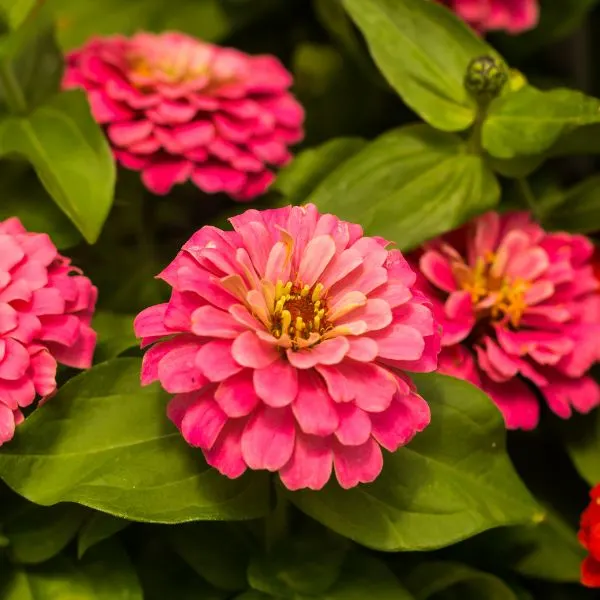
Zinnias are hardy flowering plants that truly add color to your garden. The flowering plant pairs well with its lavender. Pairing the variety of red, pink, lavender, and white colored zinnias work pretty well with the light-colored, smaller blooms of the lavender plant. The two plants have similar needs – they are both sun-loving and can put up with heat and humidity.
7. Marigolds
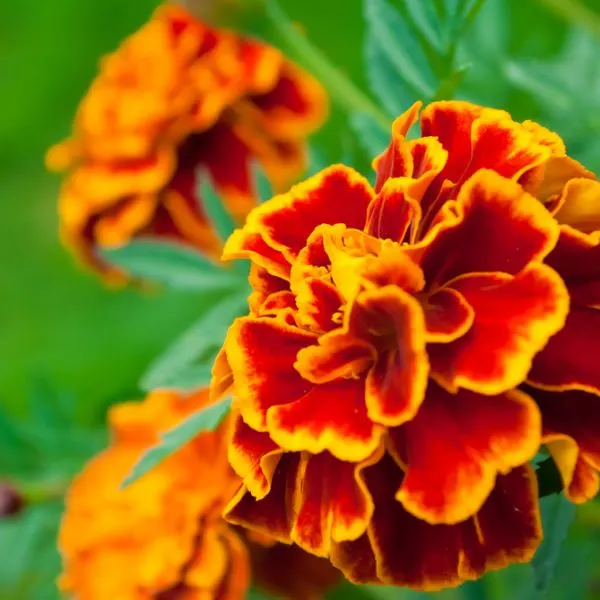
Planting marigolds with lavender instantly transforms your garden into a stunning piece of work. Available in different colors, sizes, and shapes, you can add marigolds to your lavender garden to achieve the design you want.
Yet, even with their ornamental advantage, marigolds are low maintenance and grow incredible blooms in any climate. Further, they survive in the same conditions as lavender in well-drained soil, full sun, and limited water supply.
But, you can give them an extra boost with fertilizer for even more glowing blooms. In addition to boosting similar growth conditions, marigolds are beneficial to lavender as they help deter pests and attract predatory insects, such as ladybugs.
8. Upright Sedum
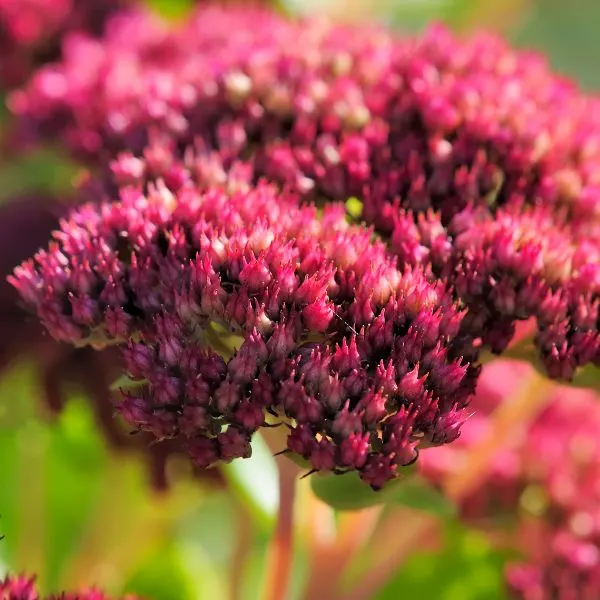
Also known as stone crop, upright sedum pairs pretty well with lavender while the colorful sedum florets accentuate the overall garden look. Sedum grows in different bloom colors, including white, pink, and red.
Sedum perhaps shares the closest growth needs compared to other companion plants. Growing in USDA zone 3 to 10, the flowering plant loves well-drained sandy and rocky soil, full sun, and occasional watering. But, upright sedum has a longer blooming period, producing flowers from summer to fall.
9. Alliums
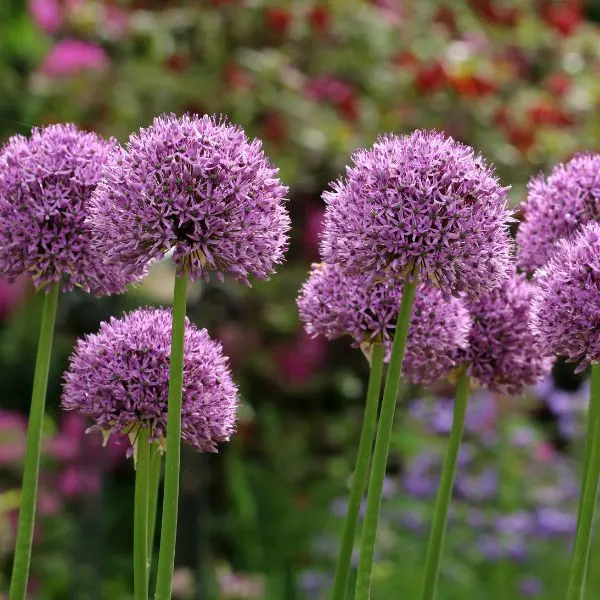
Alliums grow long beautiful darker lilac blooms that blend well with the lighter lavender. These brightly colored flowers work particularly well for a landscaping job, whether you put them in a pot or on the ground. After all, they have the same growth needs, so pairing them together, even in a pot, shouldn’t be an issue.
10. Blanket Flowers

Also known as gaillardia, the blanket flower resembles daisies, with their contrasting shape pairing well with the thinner lavender. The blanket flowers develop a deep, burn-red interior that transitions to an orange and yellow exterior on the blooms.
Pairing it with light-colored lavenders surely guarantees a striking pop of color in your garden. These plants have the same low-maintenance growing needs as lavender and a longer blooming period, from summer to fall, to keep your garden looking elegant for longer.
11. Oleander
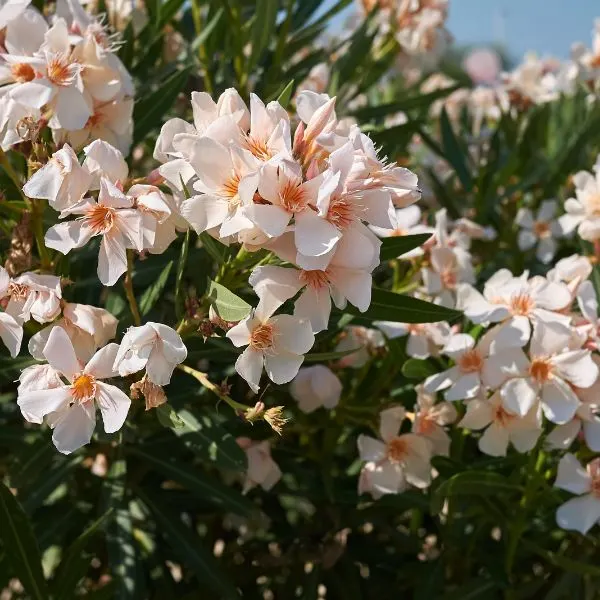
Oleander is a perfect addition to your garden landscape, complementing it with its thick, fast-growing shrub. The flowering plant tolerates drought, heat, and poor soils to produce all year round blooms. But, when you pair oleander with lavender, you want to leave adequate space between the two. After all, the shrub can grow up to 15 feet wide.
Note: Oleander can be poisonous, so you want to take extra precautions.
Herbs
12. Chamomile

Chamomile is just as beautiful as an ornamental plant as it is a culinary herb. The plant develops beautiful blooms that truly highlight your garden when paired with lavender. The herb also comes with many uses, including making delicious tea.
Chamomile pairs well with lavender and other friendly herbs, such as rosemary. When added to your lavender garden, chamomile boasts natural anti-bacterial and anti-fungal properties that keep these microbes away.
Like lavender, chamomile is also friendly with onions and cucumbers. So, when paired with lavender and these vegetables, it helps to improve their growth and flavor.
13. Rosemary
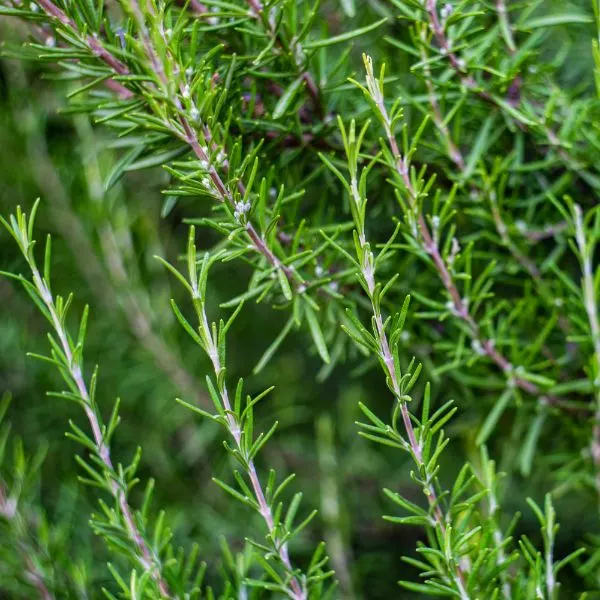
Herbs are a popular companion option for lavender. Rosemary, in particular, is a classic lavender companion plant. Rosemary and lavender are traditionally Mediterranean plants and are drought tolerant plants.
Moreover, these two herbs stand out as stunning ornamental flowering herbs. They are also edible and add to a rich herb garden. After all, what’s better than enjoying fresh herbs from your own garden at home?
Whether you are searing steaks or adding lavender to your tree, it’s always a good idea to have a good supply in your garden. Plus, both rosemary and lavender complement one another, attracting pollinators and keeping pests out.
As if this is not enough, the nearly similar structures of rosemary and lavender pair well together as a hedge. The green parts of both plants accentuate the lavender blooms for a beautiful, border-forming hedge.
Setting up a hedge comes with a variety of benefits, including a unique shape in the garden, stunning color contrast, and beautiful fragrances. These hedges also attract excellent pollinators and grow particularly well near the ocean. A hedge will also do wonders for your property, helping prevent soil erosion and promoting windbreaker.
Fun fact: Rosemary and lavender help deter rabbits and deer!
14. Blue Fescue
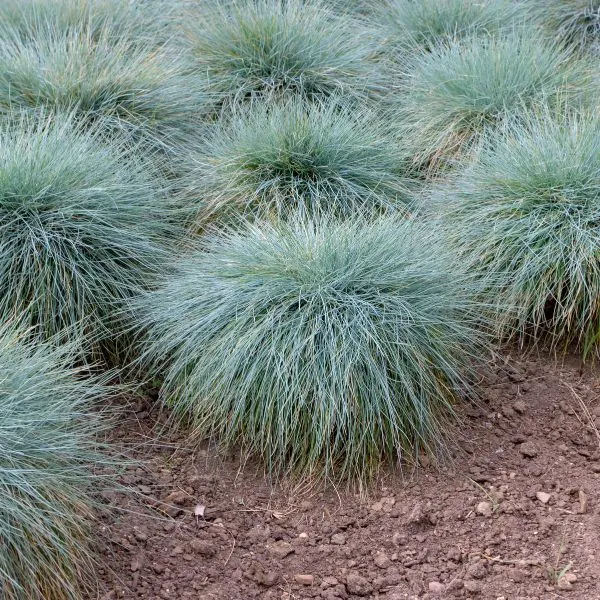
While technically not herbs, blue fescue grows into thick icy blue foliage that effortlessly complements and highlights a lavender hedge. In fact, these ornamental grass perfectly complement a lavender and rosemary hedge and highlight their blooms. Blue fescue also grows pastel feathery flowers to create a textured contrast.
The colorful ornamental grass grows perfectly with lavender since they share the same growing conditions, with blue fescue having a strong affinity to well-drained soil. The shade it gets from the lavender and rosemary hedge can offer enough shade to promote the growth of its flowers.
15. Thyme
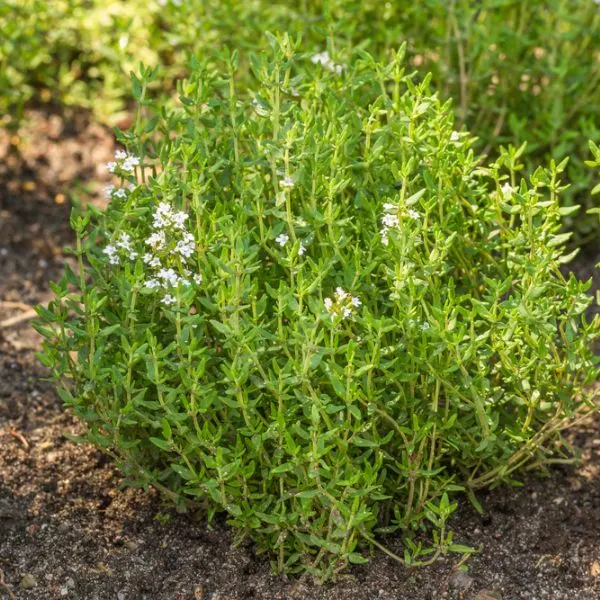
Thyme is also a great addition to your lavender herb garden. Unlike other companion plants, thyme doesn’t just pair well with lavender. It also grows well with lavender companion herbs like rosemary. So, you can bunch up a generous supply of these edible herbs together.
Further, unlike other plants, thyme can effortlessly survive the winter season after thoroughly protecting it during its very first season. Thyme grows pale flowers that complement lavender pretty well as ground cover.
16. Parsley
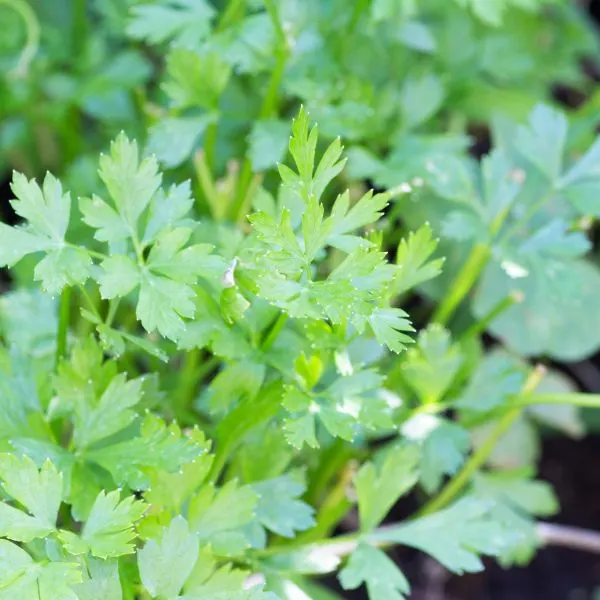
If you are looking for other easy-to-grow herbs to add to your lavender garden, parsley should be the answer. The concentrated green color of the parsley herbs offers excellent ground cover and accentuates the lavender blooms. Further, parsley can grow easily in lavender growth conditions, making pairing the two pretty easy.
17. Oregano
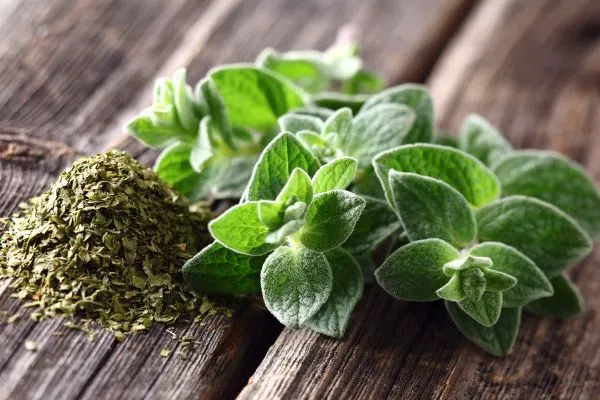
Like parsley, oregano is an excellent companion herb for many plants, including lavender. In addition to its culinary advantage, the unique green color and shape of the herb provide superior ground cover for lavender.
You can also use oregano as an edging plant. But, oregano doesn’t only benefit lavender for its ornamental advantage. If you struggle to attract pollinators, such as bees, in your lavender garden, oregano can help with the job.
18. Sage
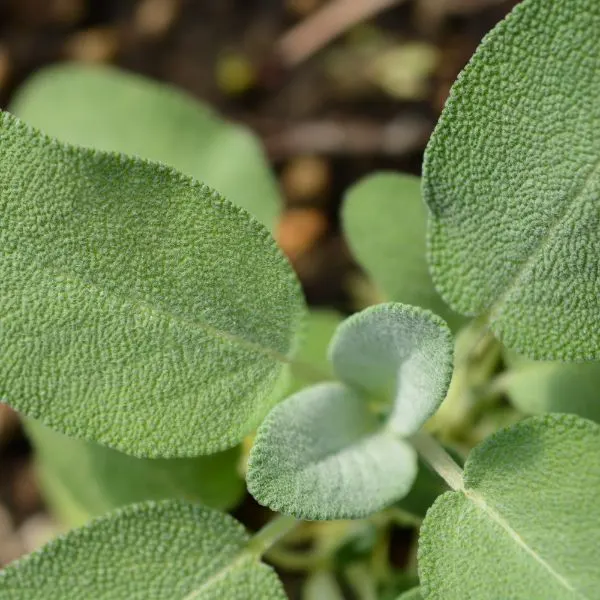
Sage boasts all the growing parameters that lavender loves. It loves a hot climate, well-drained soils, and minimal watering. Therefore, it makes a fantastic lavender companion plant. In fact, for the best results, you want to pair sage, thyme, rosemary, and lavender for the ultimate culinary herb garden.
The best part is this setup works, whether you have an extensive hardened space or a mini balcony. After all, you can pair the herbs in a pot, container, or ground.
19. Marjoram
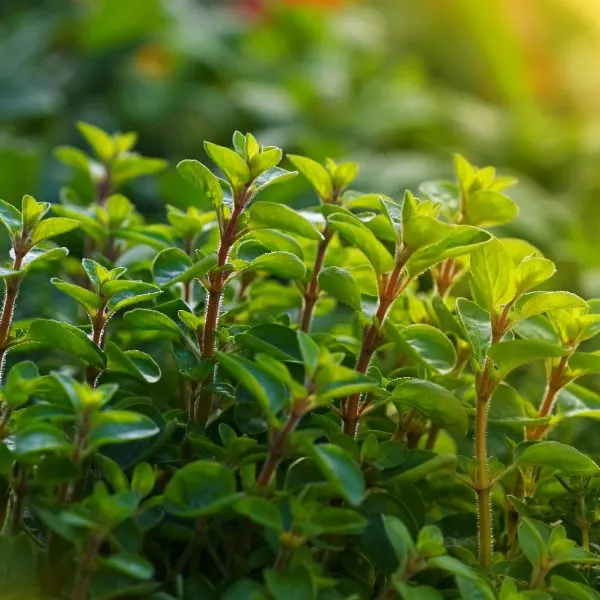
Marjoram is another popular lavender companion herb, along with lemon balm, tarragon, and caraway. Like lavender, the herb grows well in full sun and well-drained soils with minimal water. Plus, its green-colored exterior complements the floral lavender pretty well.
20. Basil

The bright green basil leaves pair well with the stunning lavender flowers for an extra green layer and texture to the garden. The herb also increases the growth and vitality of lavenders and helps deter unwanted pests.
21. Artemisia
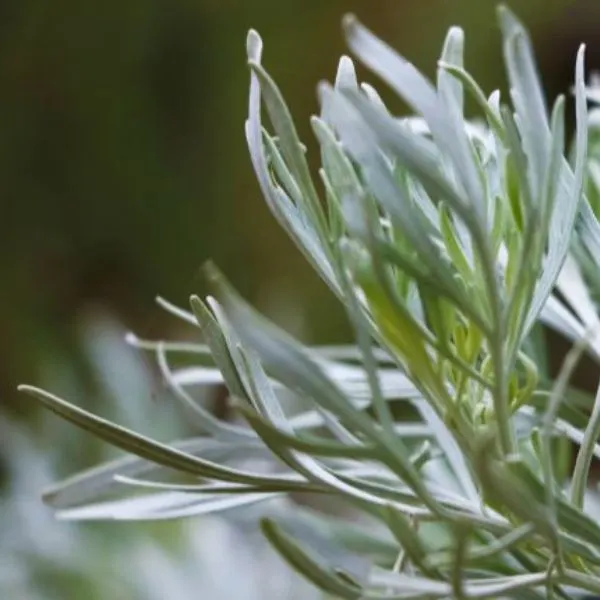
Also known as mugwort, Artemisia is an herbaceous shrub that develops beautiful blooms and a fragrant smell. When paired with lavender, the contrasting colors of the two plants create a striking ornamental setup. Artemisia grows silver-gray leaves that pair perfectly with the bold-colored tiny lavender blooms.
Artemisia is also beneficial to lavenders as it helps to repel unwanted pests. Artemisia can even be planted to keep mosquitoes out. But, Artemisia loves slightly moist soil and shaded areas. So, if you want to pair the two, you should position Artemisia around the shadier and slightly moist part of your garden, ideally a cooler woodland part of a perennial garden.
22. Cat Mint
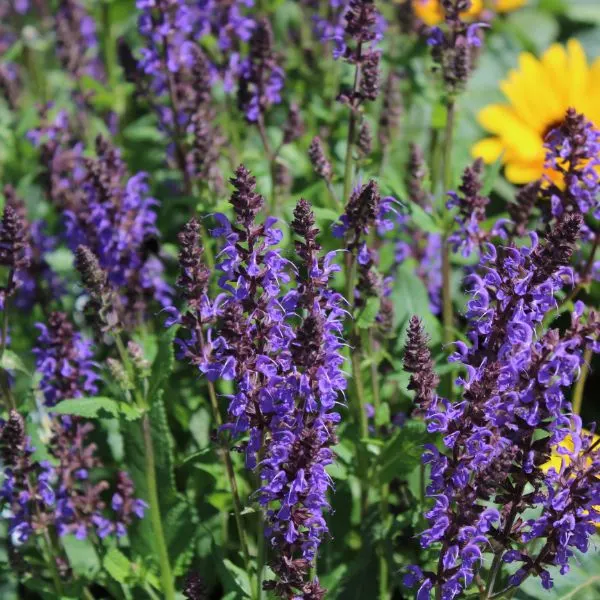
Cat mint develops tiny lavender flowers that resemble lavender’s blooms. So, planting the two together creates a pretty interesting lavender contrast, particularly when using a border bed. While regular mint doesn’t grow well with lavender, cat mint boasts similar growth needs to that of lavender to make it an ideal companion plant. Additionally, cat mint isn’t as invasive as regular mint.
Vegetables
23. Olives
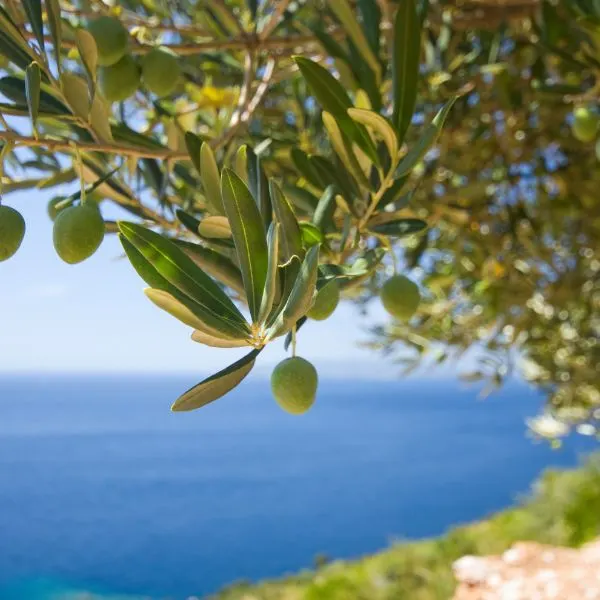
The olive tree and lavender prefer hot, dry summers. So, you can add olive trees to your garden for a complete Mediterranean look along with other Mediterranean herbs. In addition to enjoying similar growth conditions, olive trees benefit from lavender as the herb helps to attract pollinators.
24. Cabbage
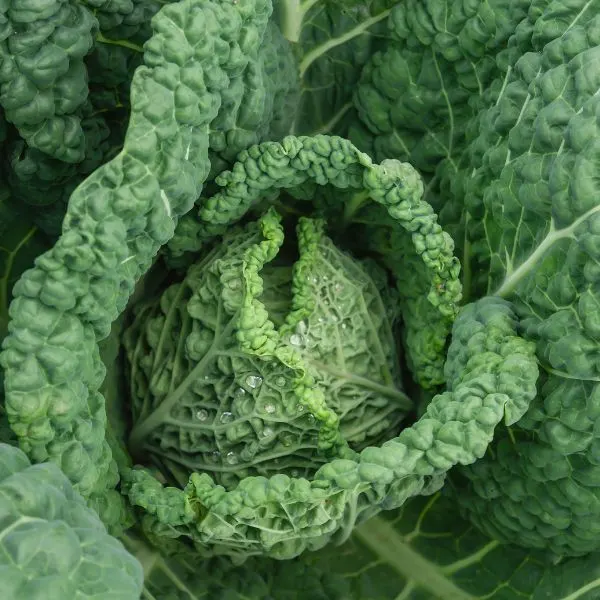
Brassica vegetables, such as cabbage, cauliflower, lettuce, and kale are incredible companion plants for lavender. These plants offer significant protection to lavender by deterring unwanted pests that lay eggs near the herbs and disrupt their growth.
25. Cucumbers

Like Brassicas, cucumber is also a good vegetable companion plant for lavender. It is particularly useful in attracting good pollinators, like bees. In turn, the bees pollinate with cucumbers and lavender.
26. Tomatoes
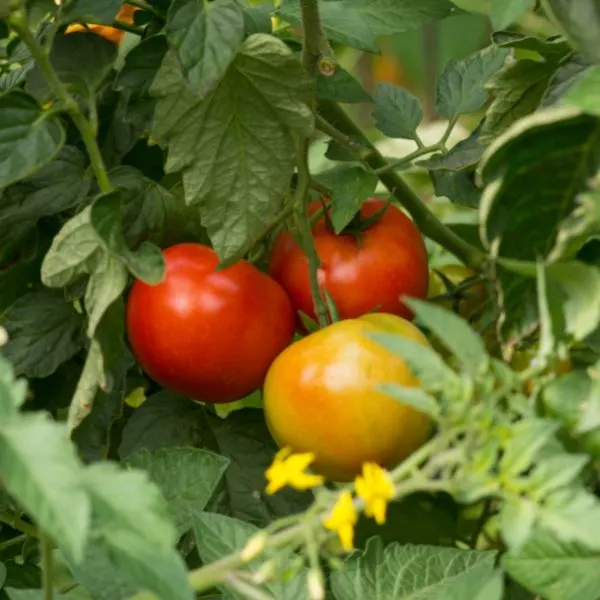
Unbeknownst to many people, tomatoes are a fantastic companion for aromatic herbs. Planting tomatoes and lavender close to one another increases a wide range of pollinators, such as butterflies and bees. On the other hand, the beautiful aroma of lavender repels unwanted pests from swarming the plants.
27. Beans
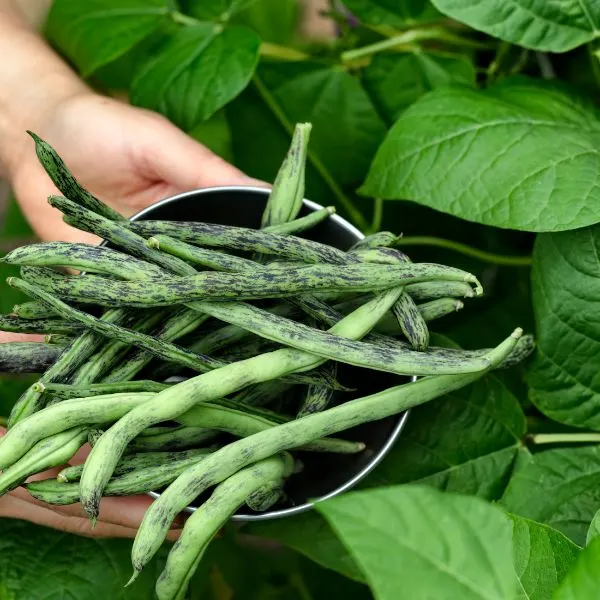
Like tomatoes, beans grow well with lavender to attract a good amount of pollinators.
28. Carrots

When planted together, vegetables like carrots and leeks aid lavender in repelling unwanted pests further. This arrangement works particularly well when carrots or leeks and lavender are paired with other vegetables, such as beans, that benefit from repelling these pests.
29. Zucchini
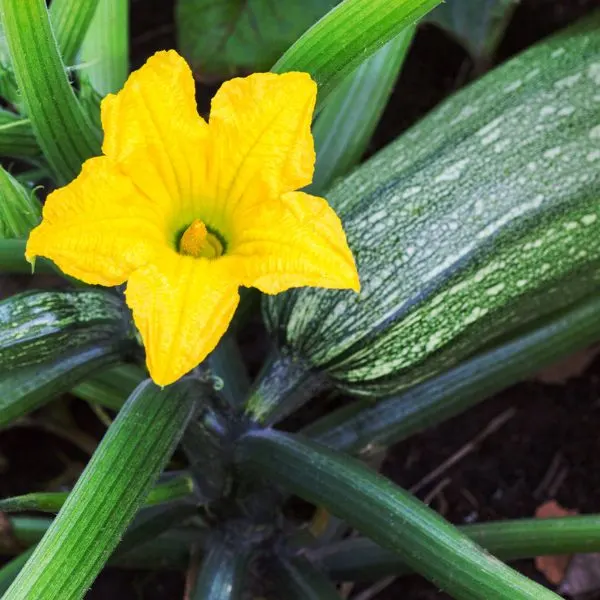
Vegetables like zucchini and squash attract bees, making them great for pairing with lavender. The bees pollinate both lavender and zucchini.
Fruits
30. Apple Tree

Fruit trees, such as apples and citrus trees, are good lavender companions and benefit when the herb is planted nearby. Typically, lavender bushes help to attract pollinators, such as bees, while repelling unwanted pests, such as moths. These pests love to target fruit trees.
7 Worst Lavender Companion Plants
Sure, lavender pairs well with multiple plants. However, it also has a list of plants you should avoid pairing it with. Here are the worst companion plants for lavender you should avoid at all costs;
Flowering Plants
1. Camellias
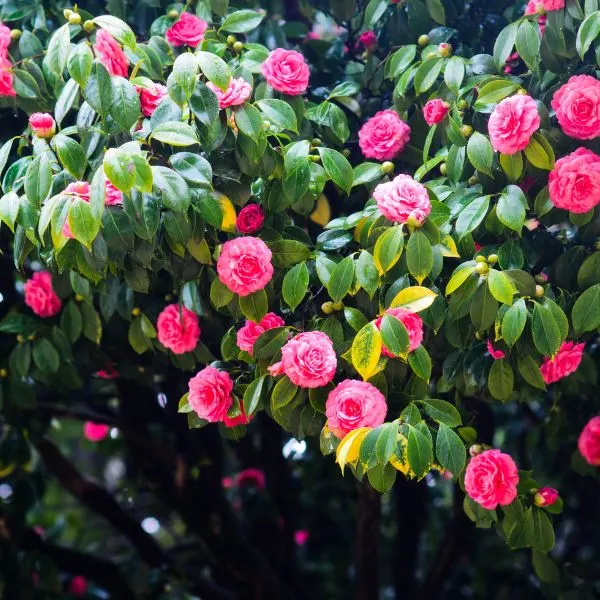
Many flowering plants grow well as lavender companion plants. But, this doesn’t mean that you can’t find some that just don’t grow well with the herb. The peony-like camellias are unfortunately one of these flowering plants.
Undoubtedly, camellias make any garden stand out with their selection of white, yellow, pink, and red blooms. However, they just won’t survive being planted near lavender. While they grow in similar zones as lavender, camellia don’t love exposure to full sun for extended periods and are quite water-loving.
2. Impatiens
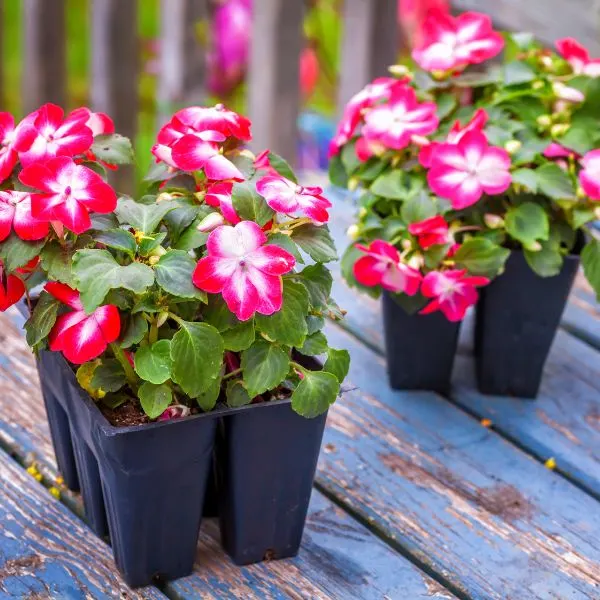
Impatiens grow beautiful multicolored blooms (white, pink, deep purple, coral, yellow, and red, to mention a few) and are very easy to care for, making them a favorite. But, they are not a favorite when it comes to pairing with lavender.
The only similarity these flowering plants have with lavender is that they grow in well-drained soil. Impatiens do well under shaded areas and don’t do so well with little water or high temperatures.
3. Hostas
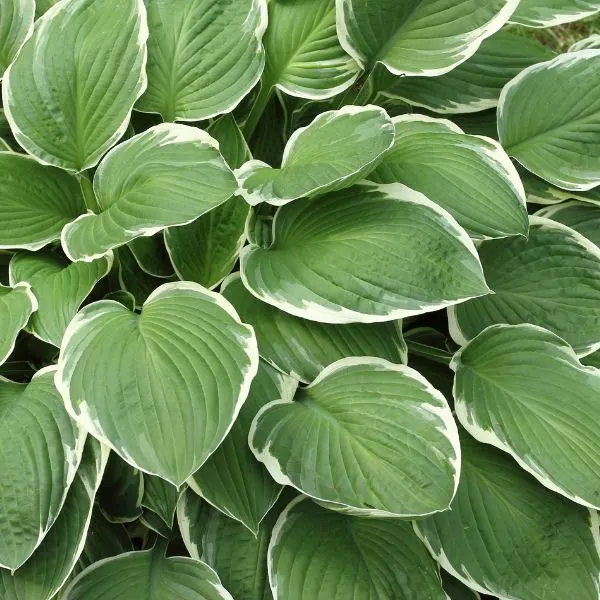
Hosta is a beautiful green perennial with excellent foliage that grows in USDA zone 3 to 11. The perennial is easy to care for and requires little water and well-drained soils to survive. But, this is as far as they go when it comes to their similarities with lavender. Plants like hosta or coleus don’t do well with lavender because they are shade loving. So, planting these perennials with the full sun-loving lavender just won’t work out.
4. Fuchsia

Like Hostas, fuchsia is shade-loving. So, this flowering plant will do horribly planted near the sun-loving lavender.
5. Daffodils

Another stellar flowering plant option for the garden, daffodils are vigorous growers. These flowers propagate, grow, and multiply pretty rapidly. This makes them unsuitable for planting near lavender as they risk invading them.
6. Dense Shrubs
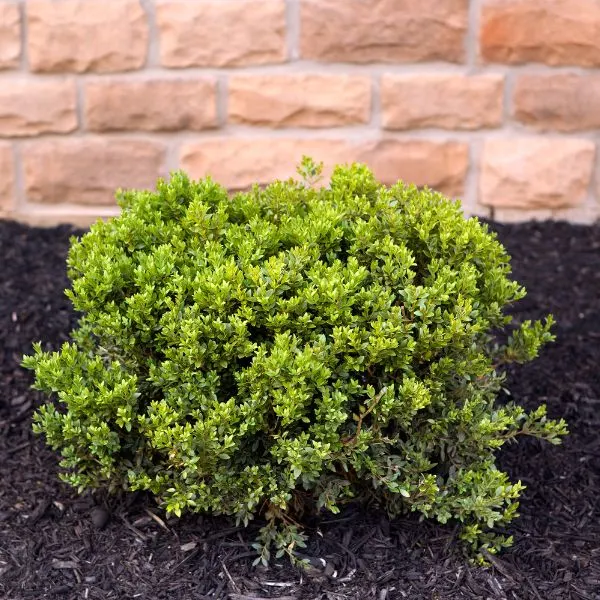
Dense shrubs don’t make great companion plants for lavender. Typically, these shrubs tend to spread and take over space. So, they are not the best companion for lavender.
Herbs
7. Mint

Mint is perhaps lavender’s worst enemy when it comes to companion planting. So, you should never grow mint near lavender. While it grows pretty easily and requires minimal maintenance, mint requires rich and moist soils and requires constant watering to thrive.
FAQs
Still have unanswered questions about companion plants for lavender? Check out this exhaustive FAQ section;
Why Plant Lavender?
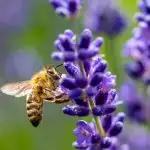
Lavender is great for planting for its ornamental and fragrant benefits guaranteed to transform your garden. Further, lavender does a good job of repelling unwanted bugs, particularly mosquitoes, moths, ticks, and fleas. Additionally, lavender attracts beneficial pollinators, such as bees and butterflies that help promote abundant fragrant blooms.
Is Lavender A Good Companion Plant?

Lavender makes an excellent companion plant thanks to its ability to repel unwanted pests and attract beneficial pollinators. Its beautiful blooms and strong floral fragrance also complement a myriad of plants.
Is Lavender Invasive?
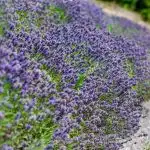
Lavender is not invasive and doesn’t spread as much as herbs, like oregano. Typically, lavender grows as a small shrub, extending to about 24 inches wide and tall. So, it doesn’t take over as much space.
What Fruits Grow Well With Lavender?
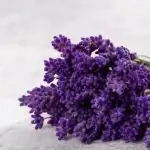
Lavender is a good companion plant for several fruit trees. The small shrub grows particularly well with fruit trees, such as apple and citrus trees.
What Vegetables Grow Well With Lavender?
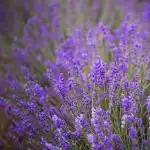
Lavender grows well with a variety of vegetables. These include Brassicas, like cabbages and kale, tomatoes, carrots, cucumbers, and onions, to mention a few. Growing lavender near vegetables benefits both plants, attracting pollinators and repelling unwanted pests.
What should not be planted with lavender?
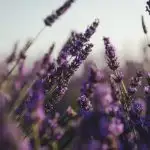
Generally, the worst companion plants for lavender usually have opposite growing conditions. Lavender grows in USDA zone 5 to 9 with well-drained soils, little watering (at least once a week), and exposure to full sun. So, shade-loving and water-loving plants will not thrive so well growing with lavender.
Plants that need fertile soils with a lot of fertilizer will not grow well near lavender either. Further, lavender loves slightly alkaline soils, so acid-loving plants don’t grow so well with the herb. In addition to these conditions, you want to look out for other characteristics. For example, invasive plants or plants that take over a lot of space don’t grow so well with lavender.
What perennials go with lavender?
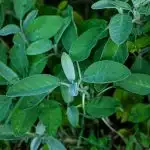
Some options of perennials complimenting lavender include: sage, catmint, Jeruselum sage, lamb’s ear, thyme, and more.
Do lavender and rosemary grow well together?
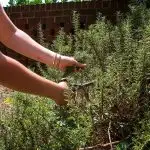
Yes, lavender and rosemary grow well together. They are both Mediterranean plants and have similar growing requirements. They both thrive in well-drained, sandy soil and full sun.
Conclusion
Lavender is most certainly one of the best plants to integrate into your garden. In addition to its beautiful ornamental and pleasant fragrant benefits, lavender is an excellent culinary herb you can integrate into cooking.
The fragrant and therapeutic herb also works great for DIYers who want to produce homemade items like candles, soaps, and lotions using dried lavender. But, enough about lavender’s advantages and uses. In the garden, the herb is a fantastic partner and grows pretty well with a range of plants.
The best companion plants for lavender don’t only benefit from their complementary ornamental and fragrant characteristics. It also does a good job of attracting good pollinators and repelling bad pests. So, whether you want to set up a herb garden or hedge, lavender never disappoints.
More companion plant articles
